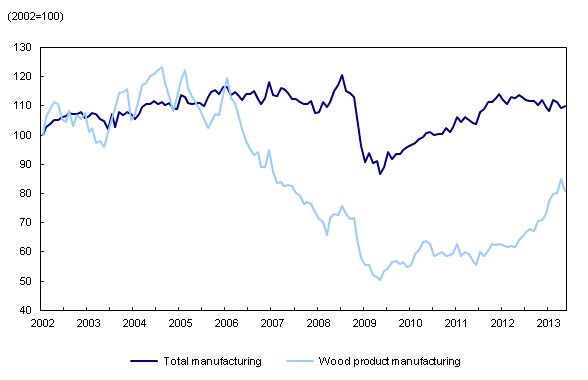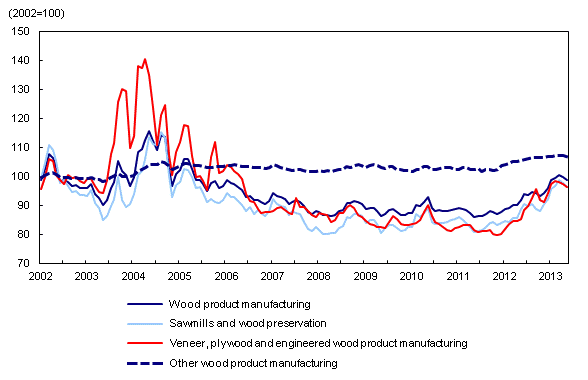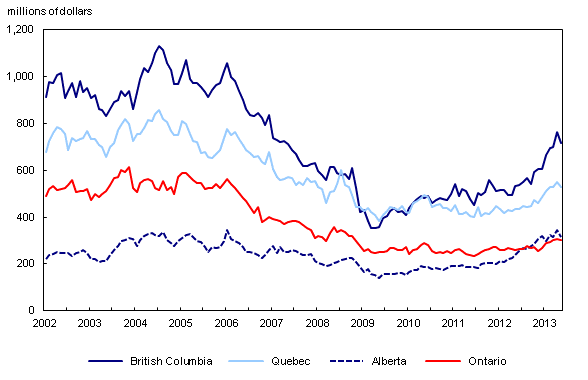Manufacturing at a Glance: Bucking the trend – Turnaround in the wood product manufacturing industry, June 2012 to May 2013
Archived Content
Information identified as archived is provided for reference, research or recordkeeping purposes. It is not subject to the Government of Canada Web Standards and has not been altered or updated since it was archived. Please "contact us" to request a format other than those available.
Released: 2013-07-24
Sales in the wood product manufacturing industry have bucked the trend in the manufacturing sector as a whole. Total sales in the wood product industry were up 19.7% over the 12-month period from June 2012 to May 2013 compared with the same period one year earlier. By comparison, total manufacturing sales in Canada, excluding wood products, decreased 1.1% over the same period. Wood product manufacturing was one of only eight industries where sales increased from June 2012 to May 2013, and represented both the largest dollar gain and largest percentage gain by industry. This paper examines the recent turnaround in the wood industry, including national and provincial trends.
National sales rise as prices and volumes rebound
Sales in wood product manufacturing reached $22.7 billion from June 2012 to May 2013, their highest point since 2007/2008.
The rebound in the industry has resulted in wood product manufacturing accounting for its largest share of Canadian manufacturing sales since 2007/2008. The wood manufacturing industry represented 3.9% of manufacturing sales from June 2012 to May 2013, compared with 3.2% during the same period a year earlier.
Higher prices and volumes were both factors in the increased sales in the wood product industry, as foreign demand rose. From June 2012 to May 2013, the average Industrial Product Price Index (IPPI) for the wood industry was 9.2% higher than the previous 12-month period, and was at its highest point since 2005/2006.
Foreign housing demand pushes the wood industry forward
The sawmills and wood preservation sub-industry was the main source of growth within the wood industry from June 2012 to May 2013. This sub-industry accounted for $10.6 billion in total sales, up $2.0 billion from the same period a year earlier. Sales also reached their highest level since 2006/2007. This sub-industry also accounted for the largest share of total wood industry sales (46.8%). Increases were attributable to higher exports to the United States as well as higher prices. Exports in the sawmill and wood preservation industry to the United States increased 36.9% from June 2012 to May 2013, up $1.2 billion from the same period one year earlier.
The rise in exports was largely attributable to growth in the US housing market. Data published by the US Census Bureau report that unadjusted housing units started in the United States reached 863,600 units from June 2012 to May 2013, up 28.9% compared with the same period a year earlier. The IPPI indicates that wood prices in the sawmills and wood preservation industry have risen 10.5% over this period as a result of increased demand.
British Columbia leads gains
In general, British Columbia has historically accounted for the largest share of wood product manufacturing in Canada. From June 2012 to May 2013, the province was responsible for 33.2% of national wood product manufacturing sales. From June 2012 to May 2013, sales rose $1.4 billion to $7.5 billion, up 22.9% from the same period one year earlier. Wood product manufacturing accounted for 19.0% of all manufacturing in British Columbia.
The sawmills and wood preservation sub-industry accounted for 66.6% of wood product manufacturing in British Columbia, a larger share than any other province. Therefore, decreases in exports and prices, which stemmed from a slowdown in the housing market, had a disproportionately greater effect on the wood product industry in British Columbia. As a result, between 2008 and 2010, British Columbia was occasionally surpassed on a monthly basis by Quebec as the largest wood product manufacturer in the country. The recent rebound in prices and exports has produced the opposite result, with British Columbia regaining its place as the largest wood product manufacturer in Canada.
Quebec maintained its role as the second largest producer of wood manufacturing products in Canada from June 2012 to May 2013, accounting for 25.7% of the national total. Over the 12-month period, the sawmills and wood preservation sub-industry also accounted for the largest share of wood product manufacturing sales in the province, at 39.7%. However, over the last decade, Quebec has seen fluctuations in which sub-industry accounted for the largest share of wood product manufacturing. From 2009/2010 to 2011/2012, other wood product manufacturing accounted for the largest share of sales, as prices in the sub-industry remained relatively stable. As wood prices and exports recovered, sawmills and wood preservation once again became the largest sub-industry in the province.
For the first time since this series began in 1992, Alberta surpassed Ontario as the third largest manufacturer of wood products. From June 2012 to May 2013, Alberta accounted for 15.7% of all sales nationally, compared with Ontario's 14.8% share. Like British Columbia, the sawmills and wood preservation sub-industry held the largest share of wood manufacturing in Alberta, and also recently benefited from an increase in prices and exports. In comparison, Ontario's wood product manufacturing is focused more heavily on other wood product manufacturing. Prices in the other wood product manufacturing industry have traditionally been more stable, rising 3.1% from June 2012 to May 2013 compared with the same period a year earlier.
Note to readers
The wood industry is divided into three sub-industries. The following is a brief description of the good manufactured within each sub-industry:
Sawmills and wood preservation: This sub-industry includes establishments primarily engaged in manufacturing boards, dimension lumber, timber poles and ties from logs and bolts.
Veneer, plywood and engineered wood product manufacturing: This sub-industry group includes establishments primarily engaged in manufacturing softwood and hardwood veneer and plywood; structural wood members, except lumber; and reconstituted wood panel products.
Other wood product manufacturing: This sub-industry group includes establishments, not classified to any other industry group, primarily engaged in manufacturing wood products. This category includes goods such as: millwork including window and door manufacturing, wood container and pallet manufacturing, manufactured (mobile) homes, prefabricated homes and miscellaneous products such as handles, kitchenware, cork products.
Contact information
For more information, contact us (toll-free 1-800-263-1136; infostats@statcan.gc.ca).
To enquire about the concepts, methods or data quality of this release, contact Michael Schimpf (613-951-9832; michael.schimpf@statcan.gc.ca), or John Seay (john.seay@statcan.gc.ca), Manufacturing and Energy Division.
- Date modified:




